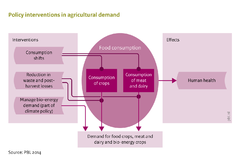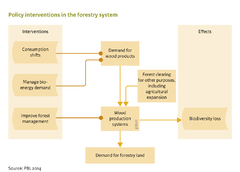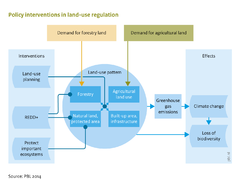Land and biodiversity policies/Data uncertainties limitations: Difference between revisions
Jump to navigation
Jump to search
No edit summary |
No edit summary |
||
| Line 7: | Line 7: | ||
==Uncertainties in technology== | ==Uncertainties in technology== | ||
In the modelling of production systems, the largest uncertainties concern the developments in productivity or yield increase. Historically, annual yields have been increasing by approximately 1%. Technological developments relate to research and plant breeding and yield developments also result from improved management practices. Both are driven, at least partly, by commodity prices, but empirical data and the quantitative modelling of these effects is still rather poor ([[Hertel et al. ...]]). A further complication is the fact that farmers may have objectives and constraints that are not covered in the economic model. Research and plant breeding is targeted, for example, to a decreased susceptibility to water scarcity, diseases and pests. Although it is uncertain whether varieties could be bred that are more efficient than current varieties, new technologies to unravel the DNA of crops could significantly accelerate the breeding process ([[Godfray et al. 2010]]). | In the modelling of production systems, the largest uncertainties concern the developments in productivity or yield increase. Historically, annual yields have been increasing by approximately 1%. Technological developments relate to research and plant breeding and yield developments also result from improved management practices. Both are driven, at least partly, by commodity prices, but empirical data and the quantitative modelling of these effects is still rather poor ([[Hertel et al., ...]]). A further complication is the fact that farmers may have objectives and constraints that are not covered in the economic model. Research and plant breeding is targeted, for example, to a decreased susceptibility to water scarcity, diseases and pests. Although it is uncertain whether varieties could be bred that are more efficient than current varieties, new technologies to unravel the DNA of crops could significantly accelerate the breeding process ([[Godfray et al., 2010]]). | ||
==Uncertainties in forestry== | ==Uncertainties in forestry== | ||
| Line 13: | Line 13: | ||
==Uncertainties in land use regulation and land use change== | ==Uncertainties in land use regulation and land use change== | ||
For land-use regulation, the effectiveness of protected areas is not always sufficient to maintain original biodiversity values ([[Leverington et al. 2010]]). For land-use change, only the economic processes of the agricultural sector are taken into account. Complex socioeconomic interactions that drive deforestation [[(Lambin et al. 2001]]) are not part of the model. Likewise, the national institutional part of land use and land-use change is hardly included, although it is well-known that the institutional part largely defines the development of landscapes and land uses. | For land-use regulation, the effectiveness of protected areas is not always sufficient to maintain original biodiversity values ([[Leverington et al., 2010]]). For land-use change, only the economic processes of the agricultural sector are taken into account. Complex socioeconomic interactions that drive deforestation [[(Lambin et al., 2001]]) are not part of the model. Likewise, the national institutional part of land use and land-use change is hardly included, although it is well-known that the institutional part largely defines the development of landscapes and land uses. | ||
The uncertainty range changes with the time horizon of the scenario, and is larger for indicators further down the modelling chain. For example, biodiversity results are largely driven by land-use change, which in turn is sensitive to uncertainties about land allocation and production systems, and finally to agricultural demand. | The uncertainty range changes with the time horizon of the scenario, and is larger for indicators further down the modelling chain. For example, biodiversity results are largely driven by land-use change, which in turn is sensitive to uncertainties about land allocation and production systems, and finally to agricultural demand. | ||
The IMAGE framework may be used to answer policy questions in different ways. Most frequently, technical interventions or assumed behavioural changes are implemented. The results from such alternative scenarios are then used to answer the respective 'what if' questions. The costs or policy measures needed to bring about such changes often cannot be modelled internally, nor can the feasibility of such options be taken into account. Only some economic instruments in the agro-economic model (e.g. a meat tax) can be modelled explicitly, and also some specific policies, such as those on [[HasAcronym::REDD+]], biofuels, or additional protected areas, can be modelled explicitly for their economic and system-wide effects. Other important transitions, such as behavioural change, can not be modelled. | The IMAGE framework may be used to answer policy questions in different ways. Most frequently, technical interventions or assumed behavioural changes are implemented. The results from such alternative scenarios are then used to answer the respective 'what if' questions. The costs or policy measures needed to bring about such changes often cannot be modelled internally, nor can the feasibility of such options be taken into account. Only some economic instruments in the agro-economic model (e.g. a meat tax) can be modelled explicitly, and also some specific policies, such as those on [[HasAcronym::REDD+]], biofuels, or additional protected areas, can be modelled explicitly for their economic and system-wide effects. Other important transitions, such as behavioural change, can not be modelled. | ||
}} | }} | ||
Revision as of 22:59, 9 December 2013
Parts of Land and biodiversity policies/Data uncertainties limitations
| Relevant overviews |
| References |



